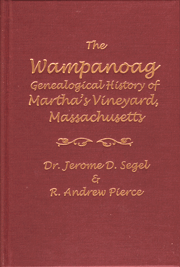 Having become interested in local land records and ownership details, Dr. Jerome (Jay) Segel researched and wrote Owner Unknown: Your guide to Real Estate Treasure Hunting. His desire to produce this book came through his interest and research in uncovering land records related to his home on Martha’s Vineyard. Through this study, Jay developed and additional interest, of not a new passion, for Indian related records. He realized few details were provided in the existing histories as to the islands original owners, the Wampanoag tribe of Native Americans.
Having become interested in local land records and ownership details, Dr. Jerome (Jay) Segel researched and wrote Owner Unknown: Your guide to Real Estate Treasure Hunting. His desire to produce this book came through his interest and research in uncovering land records related to his home on Martha’s Vineyard. Through this study, Jay developed and additional interest, of not a new passion, for Indian related records. He realized few details were provided in the existing histories as to the islands original owners, the Wampanoag tribe of Native Americans.
Segel’s interest grew beyond land records to a desire to know every detail about these native people who made it possible for the original European colonists to survive. Without the support of the native people, the earliest colonists would likely never have learned to cultivate the local land, fish the waters, catch whales, or learn which local plants were edible. Putting together a small team of supporters and researches, chief among them Richard Andrew Pierce, a professional genealogists, they spent years researching every possible record in order to put together The Wampanoag Genealogical History of Martha’s Vineyard, Massachusetts: Referenced to Bank’s History of Marha’s Vineyard, Mass.; Volume 1: Island History, People and Places from Sustained Contact Through the Early Federal Period.
The records uncovered provide details on some of the oldest American lineages, several dating back to the 1500s. Research for this book took the authors from coast to coast, and over to Europe; including, research in Sweden, England, Scotland, and France. Records of every type were unearthed and fully examined; including, nearly indecipherable source materials like disputes, debt cases, letters, births, marriages, and death records. Account book, sea voyages, Indian and colonial records, land, judicial, military, maritime, and religious histories all contributed varying amounts of information. Literally, every scrap of paper with names and information related to the Native population were examined and cross referenced in order to provide as detailed a book as possible. The result is nearly 680 pages of native genealogical information, the likes of which exist for few Native American groups.
Contents
About the Authors and Contributors
Preface
Introduction
About Volume 1
How to Use This Book
Part 1: Background to the Research
Records, Repositories, and Resources
Historical Repositories and Services Used
Impact of Colonial Law on Genealogical/Historical Research
Abbreviations
Native New England Chronology: In Historical Context
European Westward Efforts, Natives, and the Vineyard
The Native Vineyard Language
The Six Sachemdoms of Martha’s Vineyard
Native Vineyard Population Statistics
Part 2: Database of Martha’s Vineyard Natives and Relations
Part 3: Appendixes
Appendix 1: Alphabetical Key to Wampanoag Database
Appendix 2: Numerical Key to Wampanoag Database
Appendix 3: Cross-reference to Settlers in Banks’ History
Appendix 4: Residents of Nantucket County in the Database
Appendix 5: Blacks & Mulattos in the Database
Appendix 6: Families Highlighted in Volumes 2 & 3
Appendix 7: Indian Converts…by: Experience Mayhew: Index
Appendix 8: Early Land Transactions: Natives to Immigrants
Appendix 9: Census Sources for Martha’s Vineyard
Appendix 10: Sachems in and Around New England
Appendix 11: Native Place Names on Martha’s Vineyard
Appendix 12: Native Village Names of New England
Part 4: Three Generation Descendancy Charts
Preview of Volume 2: Family Genealogical History: Able
Acknowledgments
Bibliography
Map — The Six Sachemdoms of Martha’s Vineyard alias Nope
The Wampanoag Genealogical History of Martha’s Vineyard, Massachusetts is available from Family Roots Publishing; Price: $83.30.